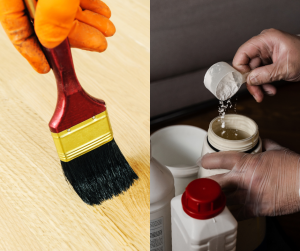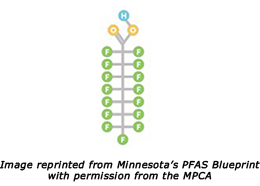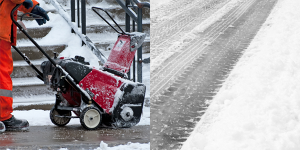December 2024
Inside the Newsletter:
Winter Salting | TRI | PFAS | Events | Funding Opportunities
Winter Salting is a Balancing Act
As winter beckons and ice starts to form on surfaces, businesses face the perennial problem of how to keep their sidewalks, parking lots, and roads safe to walk and drive on. Salt, mainly sodium chloride, is an undeniably powerful tool as salt lowers water’s freezing point so that ice can melt below 32˚Farenheit.
On the flip side, it takes around one teaspoon of salt to permanently pollute five gallons of water as there is no feasible and affordable way to filter out salt from freshwater. High levels of chloride can threaten fish, amphibians, aquatic bugs, birds, and plants that are vital to healthy, local ecosystems. Pets licking salt from their paws can get sick. Soils with high levels of salt are less effective in soaking in precipitation and holding nutrients in place, which in turn leads to increased water pollution and erosion. Salt can increase repair and maintenance costs on key infrastructure, like roads and bridges, as chloride wears down paved surfaces and weakens reinforcing rods.
Fortunately, there are many useful training to help balance applying enough salt to keep surfaces safe while reducing chloride pollution. MnTAP recommends the Minnesota Pollution Control Agency’s Smart Salting training. MPCA hosts a variety of no-cost training sessions geared towards different workers, including snowplow operators and property managers. Topics will depend on the audience but could include regulatory issues and liability; analyzing winter weather data before salting; and best management practices in calibrating and setting application rates for salt spreaders, plowing or physically removing snow, and storing salt to reduce chloride runoff. To see what MPCA Smart Salting Trainings are coming up soon for industrial businesses, hospitals, and cities, please scroll down to the “Upcoming Events” section to learn more.
For businesses that need a refresher or starting place, here is a quick list of salting tips, and many of these come from the Low Salt. No Salt. Minnesota program.
- Improve pedestrian safety from slips and falls by closing off seldom used entrances. Putting up physical barriers to help focus foot traffic to a few entrances can reduce the areas (e.g., sidewalk and parking lots) that a business needs to apply salt on. Consider blocking off areas where winter-related slips and falls seem to occur more frequently than elsewhere on the property.
- Repair areas where ice often builds up. Ice easily forms on cracked sidewalks or areas, such as low-lying areas or depression in landscapes, that collect precipitation. Repairing sidewalks and reducing storm runoff with proper grading and drainage or rain gardens could reduce the number of icy surfaces. It might be worth consulting with an expert in the spring or summer if the commercial property has significant grading and drainage problems.
- Promptly clear walkways and roads after snow falls to eliminate the need to salt or at least reduce the amount of salt needed. Shovels, snowplows, ice scrapers, and snow blowers are great ways to remove ice and snow, especially early on before snow can turn into ice. Physically removing snow and ice might be enough to keep pathways and roads safe without needing additional salt or sand.
- Understand what salt can and cannot do. Salt is effective in loosening ice to make it easier to remove by shoveling or plowing. This process can take time, and adding more salt will not quicken ice melting. Rock salt is ineffective as a pretreatment in anticipation of snow, on bare pavement, or on top of snow, which salt then turns into slush. Salt used for pretreatment often accumulates in piles of snow on parking lots or dumped on green spaces, and this salt eventually makes its way into local waterways and water bodies.
- Only use salt when the temperature is above 15˚Fahrenheit. Typical rock salt will not melt ice if it is colder than 15˚ Fahrenheit. Consider using sand or grit to improve grip or traction on walkways and parking lots.
- Know that a little salt goes a long way. Since one salt grain melts a three-inch circular area of ice, try to have three inch spaces between salt granules. Other rules of thumb to keep in mind when applying salt include:
- Each parking stall takes around two-thirds of a coffee mug of salt.
- One coffee mug’s worth of salt is enough for 10 sidewalk squares or a 20-foot driveway.
- Sweep leftover salt and sand. Once ice is gone, salt is no longer useful, and left unattended, can damage a commercial property’s landscaping, flooring, or other hard surfaces. All excess salt after ice or snowmelt should be swept up. Some of this salt could be reused, and other salt must be disposed of. Please check the local regulations to see if salt can be discarded in the regular trash.
Effective winter parking lot and sidewalk maintenance helps businesses reduce slips and falls while saving money on salt, protecting landscapes and infrastructure from corrosion that comes with oversalting, and preserving our environment.
Jocelyn Leung – Communications Specialist
leung077@umn.edu
Using Toxic Release Inventory (TRI) Information to Reduce Hazardous Chemicals in Industry

The Minnesota Technical Assistance Program (MnTAP) is renewing its focus on industrial hazardous waste reduction. The current effort is focused on developing a series of case studies to highlight businesses that have already made changes to reduce their use of hazardous chemicals. Once developed, the team plans to use these case studies as a basis for a new effort focused on hazardous chemical reduction, and these case studies will provide templates that other businesses can follow to achieve similar hazardous chemical reduction results.
The MnTAP team is using the EPA Toxics Tracker Database to download data from the Toxic Release Inventory (TRI). That data is then graphed using Excel macros to visualize the past five years of chemical usage for each site. The resulting graphs are reviewed to find sites with significant TRI chemical reductions during this time frame. This team is initially focusing on solvents and cleaning chemicals. Solvents and cleaning chemicals are familiar to MnTAP, known to have safer alternatives, and are quite common to encounter in general MnTAP technical assistance.
As the list of sites is developed, the MnTAP team will reach out to these companies to explain this project and develop case studies with them documenting how they have successfully reduced their usage of hazardous chemicals. For interested companies, the team will schedule a site visit to discuss the project in depth, collect pictures for the article, and offer additional no-cost technical assistance services.
The first case study is in development. In 2019, this company chose to trial a new paint finishing product as an alternative to ethylbenzene. The new product managed to improve the final finish quality of the furniture while being less hazardous. This change allowed the company to reduce their usage of ethylbenzene to be less than the reportable threshold, to help keep the air cleaner, and to save some hazardous waste management tasks.
MnTAP plans to write a total of three to five of these hazardous chemical reduction case studies over the next six months. These case studies will serve as the foundation for a planned special project to share success stories and what was learned, inspire and encourage other companies still using these chemicals to make similar hazardous chemical reductions, and help MnTAP reach out to more companies that could use assistance.
Jon Vanyo – Senior Engineer
jvanyo@umn.edu
Breaking the PFAS Cycle

Per – and polyfluoroalkyl substances (PFAS), or forever chemicals, have been in the news a lot over the last few years. As their name suggests, these compounds do not readily break down in the environment, and due to their persistence, are attributed to a host of human and environmental health impacts.
MnTAP has shared several articles discussing the importance of PFAS source identification and reduction, and the associated project work occurring. Now, a related project is starting with a on breaking the PFAS cycle through PFAS destruction technology.
As part of LCCMR Project 2024-257: Breaking the PFAS Cycle, MnTAP is partnering with Barr Engineering, the University of St. Thomas, the City of St. Cloud WWTP, and 374Water to evaluate a technology to destruct these “indestructible” compounds. The project will evaluate the use of Supercritical Water Oxidation (SCWO) to destroy PFAS-laden media, such as granular activated carbon (GAC) and biosolids using a regional treatment model. During the summer of 2025, a demonstration pilot will be set up at the St. Cloud Wastewater Facility to test this technology with spent GAC and biosolids.
Once the pilot equipment is set up and running, a MnTAP intern and University of St. Thomas undergraduate student will partner to help characterize the efficacy of the technology and its performance with support from the project team. The project seeks to have answers to the following:
- What are operational considerations and maintenance needs, and associated O&M costs?
- What is the efficiency of PFAS mineralization?
- What is the efficiency of energy recovery and reuse?
- What are characteristics, nutrient content, and potential reuse options of residual solids?
- What are the quality and potential reuse options for condensate water?
This project is possible due to the financial support from the Environmental Natural Resources Trust Fund (ENRTF) and the support of the Legislative-Citizen Commission on Minnesota Resources (LCCMR).
Kelsey Klucas – MnTAP Director
kluc0035@umn.edu
UPCOMING EVENTS
Smart Salting: Parking Lots and Sidewalks Certification Training
January, 15, 2025, 8:00AM – 1:30PM
Virtual, No-Cost
This training is offered by MPCA to private winter maintenance companies and city, park, hospital, and school maintenance professionals. Participants earn a five-year certification for attending this training and passing the test. Learn more about this training and register for the January 15th training course.
Smart Salting: Property Management Certification Training
February, 4, 2025, 8:00AM – 1:30PM
Virtual, No-Cost
This training is offered by MPCA to property managers and business owners, and it focuses on how to reduce salt use and costs while maintaining safe walking surfaces at facilities. Participants earn a three-year certification for attending this training and passing the test. Learn more about this training and register for the February 4th training course.
Funding Opportunities
- Industrial facility air toxic and criteria emission reduction grant (MPCA): Deadline is 4 pm CT on January 22, 2025.
- Solid waste/wastewater PFAS treatment grant (MPCA): Deadline is 4 pm CT on February 14, 2025.
- PFAS source identification and reduction grant program (MPCA): Rolling deadline until 4 pm CT on April 2, 2025
- Locomotive Idle Reduction (MPCA): Rolling deadline until 4 pm CT on June 30, 2025.
- Environmental assistance loans for capital costs associated with environmental processes and technologies (MPCA & private financial institutions)
- Small business environmental improvement loans [0% interest for capital equipment purchases] (MPCA)
